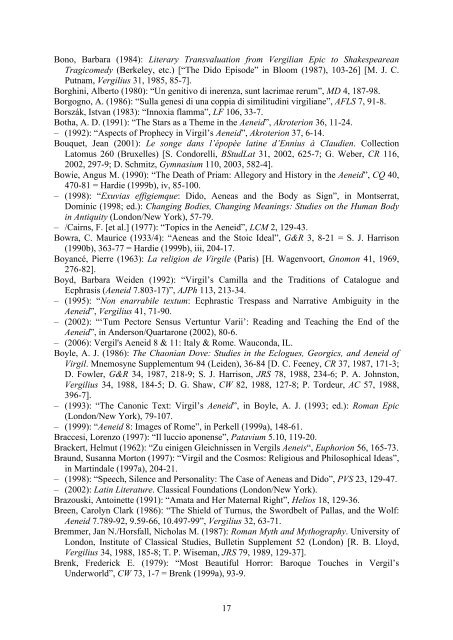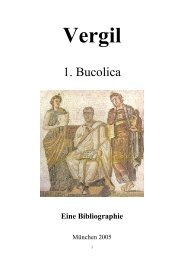You also want an ePaper? Increase the reach of your titles
YUMPU automatically turns print PDFs into web optimized ePapers that Google loves.
Bono, Barbara (1984): Literary Transvaluation from <strong>Vergilian</strong> Epic to Shakespearean<br />
Tragicomedy (Berkeley, etc.) [“The Dido Episode” in Bloom (1987), 103-26] [M. J. C.<br />
Putnam, Vergilius 31, 1985, 85-7].<br />
Borghini, Alberto (1980): “Un genitivo di inerenza, sunt lacrimae rerum”, MD 4, 187-98.<br />
Borgogno, A. (1986): “Sulla genesi di una coppia di similitudini virgiliane”, AFLS 7, 91-8.<br />
Borszák, Istvan (1983): “Innoxia flamma”, LF 106, 33-7.<br />
Botha, A. D. (1991): “The Stars as a Theme in the <strong>Aeneid</strong>”, Akroterion 36, 11-24.<br />
– (1992): “Aspects of Prophecy in Virgil’s <strong>Aeneid</strong>”, Akroterion 37, 6-14.<br />
Bouquet, Jean (2001): Le songe dans l’épopée latine d’Ennius à Claudien. Collection<br />
Latomus 260 (Bruxelles) [S. Condorelli, BStudLat 31, 2002, 625-7; G. Weber, CR 116,<br />
2002, 297-9; D. Schmitz, Gymnasium 110, 2003, 582-4].<br />
Bowie, Angus M. (1990): “The Death of Priam: Allegory and History in the <strong>Aeneid</strong>”, CQ 40,<br />
470-81 = Hardie (1999b), iv, 85-100.<br />
– (1998): “Exuvias effigiemque: Dido, Aeneas and the Body as Sign”, in Montserrat,<br />
Dominic (1998; ed.): Changing Bodies, Changing Meanings: Studies on the Human Body<br />
in Antiquity (London/New York), 57-79.<br />
– /Cairns, F. [et al.] (1977): “Topics in the <strong>Aeneid</strong>”, LCM 2, 129-43.<br />
Bowra, C. Maurice (1933/4): “Aeneas and the Stoic Ideal”, G&R 3, 8-21 = S. J. Harrison<br />
(1990b), 363-77 = Hardie (1999b), iii, 204-17.<br />
Boyancé, Pierre (1963): La religion de Virgile (Paris) [H. Wagenvoort, Gnomon 41, 1969,<br />
276-82].<br />
Boyd, Barbara Weiden (1992): “Virgil’s Camilla and the Traditions of Catalogue and<br />
Ecphrasis (<strong>Aeneid</strong> 7.803-17)”, AJPh 113, 213-34.<br />
– (1995): “Non enarrabile textum: Ecphrastic Trespass and Narrative Ambiguity in the<br />
<strong>Aeneid</strong>”, Vergilius 41, 71-90.<br />
– (2002): “‘Tum Pectore Sensus Vertuntur Varii’: Reading and Teaching the End of the<br />
<strong>Aeneid</strong>”, in Anderson/Quartarone (2002), 80-6.<br />
– (2006): Vergil's <strong>Aeneid</strong> 8 & 11: Italy & Rome. Wauconda, IL.<br />
Boyle, A. J. (1986): The Chaonian Dove: Studies in the Eclogues, Georgics, and <strong>Aeneid</strong> of<br />
Virgil. Mnemosyne Supplementum 94 (Leiden), 36-84 [D. C. Feeney, CR 37, 1987, 171-3;<br />
D. Fowler, G&R 34, 1987, 218-9; S. J. Harrison, JRS 78, 1988, 234-6; P. A. Johnston,<br />
Vergilius 34, 1988, 184-5; D. G. Shaw, CW 82, 1988, 127-8; P. Tordeur, AC 57, 1988,<br />
396-7].<br />
– (1993): “The Canonic Text: Virgil’s <strong>Aeneid</strong>”, in Boyle, A. J. (1993; ed.): Roman Epic<br />
(London/New York), 79-107.<br />
– (1999): “<strong>Aeneid</strong> 8: Images of Rome”, in Perkell (1999a), 148-61.<br />
Braccesi, Lorenzo (1997): “Il luccio aponense”, Patavium 5.10, 119-20.<br />
Brackert, Helmut (1962): “Zu einigen Gleichnissen in Vergils Aeneis“, Euphorion 56, 165-73.<br />
Braund, Susanna Morton (1997): “Virgil and the Cosmos: Religious and Philosophical Ideas”,<br />
in Martindale (1997a), 204-21.<br />
– (1998): “Speech, Silence and Personality: The Case of Aeneas and Dido”, PVS 23, 129-47.<br />
– (2002): Latin Literature. Classical Foundations (London/New York).<br />
Brazouski, Antoinette (1991): “Amata and Her Maternal Right”, Helios 18, 129-36.<br />
Breen, Carolyn Clark (1986): “The Shield of Turnus, the Swordbelt of Pallas, and the Wolf:<br />
<strong>Aeneid</strong> 7.789-92, 9.59-66, 10.497-99”, Vergilius 32, 63-71.<br />
Bremmer, Jan N./Horsfall, Nicholas M. (1987): Roman Myth and Mythography. University of<br />
London, Institute of Classical Studies, Bulletin Supplement 52 (London) [R. B. Lloyd,<br />
Vergilius 34, 1988, 185-8; T. P. Wiseman, JRS 79, 1989, 129-37].<br />
Brenk, Frederick E. (1979): “Most Beautiful Horror: Baroque Touches in Vergil’s<br />
Underworld”, CW 73, 1-7 = Brenk (1999a), 93-9.<br />
17



